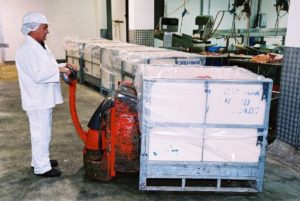What is the worker’s role in reducing the risks associated with manual tasks?
There is a general duty of employees to take reasonable care for their own health and safety and avoid harming others. Duties of employees include:
- following instructions
- using personal protective clothing and equipment provided by employers
- taking care of equipment
- reporting hazards.
Workers’ responsibilities in regard to manual tasks include:
- reporting to their supervisors any hazards associated with manual tasks
- participating in discussions about problems, identification, implementation and review of possible solutions
- implementing control measures relevant to their jobs and providing feedback about the effectiveness (or otherwise) of the controls
- participating in training related to reducing the risks.

A mechanised pallet jack eliminates lifting bulk meat packs
Courtesy of Meat and Livestock Australia
Slips, trips and falls
What are the types of hazards that may result in slips, trips and falls?
The meat industry has a high incidence of injuries caused by slips, trips and falls. Slips, trips and falls may occur during manual tasks.
The most common hazards that increase the risks of slips, trips and falls are:
- floor surfaces – slippery, uneven or damaged
- ramps – slippery or damaged, the gradient (or slope)
- stairs – slippery, no hand rail support or barrier to stop people falling over the edge
- platforms – slippery, no barrier to stop people falling over the edge
- drains and gutters – differences in levels of adjoining surfaces, pooling or build-up of material
- obstructions or obstacles in any work area or pathways, including electrical cords, hoses and any other piece of mobile equipment such as trolleys
- inadequate or poor lighting.
Additional factors that make floors, platforms and walkways slippery and may contribute to slips, trips and falls in the meat industry include:
- fat, blood, meat scraps, water and other waste products
- hot water and detergents in the cleaning and washing down process.
What can be done to reduce the incidence of slips, trips and falls?
As with all hazards the process is to:
- Identify areas or processes where slips, trips and falls may occur. Records of previous incidents and injuries, as well as consideration of industry information, the consultation with employees about areas of concern, and observation by inspections, audits or surveys.
- Assess all the factors that may contribute to an accident. When thinking about the floor surfaces, platforms, ramps, stairs, drains and gutters, obstructions and lighting, think about maintenance as well as housekeeping. Each workplace is different. A checklist may help but also always be on the alert to identify hazards and do something about them before they cause accidents
- Identify appropriate controls. Remember to consider the most effective controls from the hierarchy of controls to ensure risks are reduced to the
- lowest possible levels. Substitution and engineering controls are effective controls and include:
- replacing the floor surface
- treating existing floors to improve grip
- fitting stairs, steps and ramps with slip resistant tread
- fitting stairs with handrails
- fitting platforms with a guard rail.
- Other controls include:
- maintenance procedures including prompt repair of damaged surfaces, equipment, fittings and leaks, blocked gutters and drains
- restricted access, where feasible, to areas that pose risks and providing signposting
- personal protective equipment of suitable footwear with slip resistant soles; as with all PPE a procedure is necessary to make sure footwear is maintained and in good condition.
A combination of control measures is often necessary.
What is the role of the worker with hazards that pose risks of trips, slips and falls?
Employees play an important role by:
- fixing simple hazards such as removing obstacles in walkways
- reporting to the supervisor any damage to surfaces, drainage issues, fittings and equipment that require repair, and incidents where slips and trips have occurred even though no injury or damage has occurred
- following all procedures and work practices that impact on the hazards, from following signage to care for footwear.
